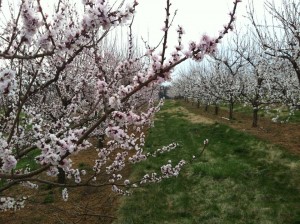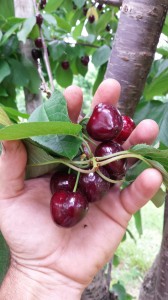One of the obvious challenges in farming is the weather.
As mentioned in previous posts, horticultural crops like tree and berry fruit, are very vulnerable to spring weather. Warm weather in the late winter can trick the plants into an early growth pattern, which can setup the plants for disaster if the weather returns to a normal pattern later in the spring.
After a snowy and normal February, we have just experienced one of the warmest March’s on record. Statewide in Pennsylvania, the average temperature was a blistering 6.3 degrees above normal for the entire month. The average high temperature for the month was nearly 10 degrees above average. Spring Peeper frogs started their chorus on March 6, nearly 4 weeks ahead of schedule, and apricots were blooming by March 22. We are experiencing the second earliest season, next to only 2012.
In 2012, we were lucky enough to dodge a major freeze during bloom. The Midwest (and Michigan in particular) was not so lucky, and they lost all of their fruit. Prices surged that year as supplies were low.
This year, we may not be so lucky. We have had several mornings near 30 this week, but worse, there are forecasts for 3 nights in the mid 20’s in the coming week. Apples are not too far along yet, but peaches, cherries, plums, and apricots are vulnerable to anything below 28.
In most professions, a knowledge of future events would allow one to take evasive action, and perhaps even benefit from what is coming. In this job, there is nothing that can be done. There are a few natural products that can be sprayed on the trees to provide a degree or two of buffer, and some big growers in Michigan have invested in large wind machines that stir calm cold air on frosty nights. But those techniques are not useful for the wind-driven blasts of cold air forecasted this week. Neither is there a futures market where risk can be hedged.
There is only one backup plan: insurance. Crop insurance is available for apples, peaches, and to a limited extent, cherries and strawberries. It is very expensive, requiring an investment of a large portion of the profits, but it can help take the sting out of a total crop failure.
And these failures may become more frequent if scientists are right about the changing climate. My data would seem to corroborate forecasted trends of increasing volatility. The last several years have shown a consistent pattern of very wet, very warm, very cold, and at times very dry. Rain events have been extreme with a very large proportion of last years’ precipitation falling in just 3 or 4 storms. Or just consider that 80% of this winters’ snowfall occurred in just one storm that set the all-time record for snowfall. In contrast, March had something like 30% of the normal precipitation for the month.
So here’s hoping for a little error in the forecast this week. Because if the weather stays just a few degrees warmer, we might even benefit from the cold. How? Because peaches usually set many more fruit than we want on the trees, and require extensive thinning. If nature does the thinning for us, we can save a little labor and improve the quality of the remaining fruit. But… I’d rather not have to worry about it so much.




